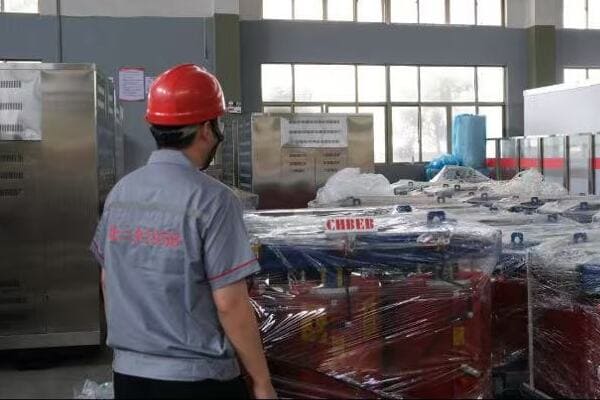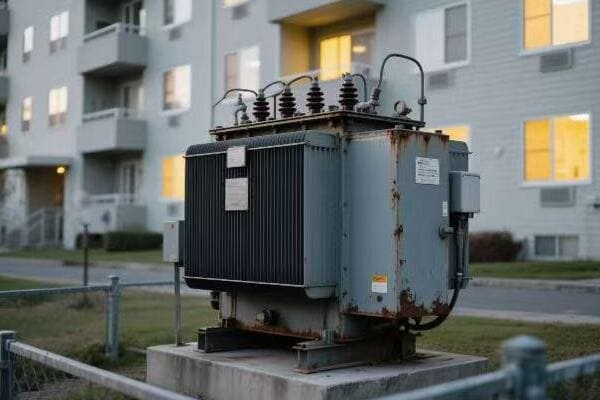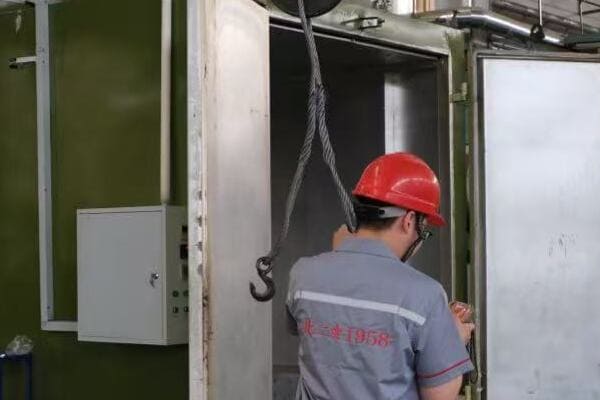Power Transformer vs Distribution Transformer: Structure, Function, and Key Differences Explained?
Are you struggling to understand the differences between power and distribution transformers? You’re not alone. Many engineers and project managers find themselves confused by these two crucial components of our electrical grid. But what if you had a clear, comprehensive guide that breaks down everything you need to know about power and distribution transformers?
Power transformers and distribution transformers differ in their voltage levels, size, and application. Power transformers handle high voltages (typically above 33kV) for long-distance transmission, while distribution transformers manage lower voltages (below 33kV) for local power delivery. Power transformers are larger, more efficient at full load, and used in substations, while distribution transformers are smaller, optimized for varying loads, and found in residential and commercial areas.

In this comprehensive guide, I’ll walk you through the key differences between power and distribution transformers, their structures, functions, and applications. Whether you’re a seasoned engineer or new to the field, this article will provide valuable insights to help you make informed decisions about transformer selection and use in power systems.
What Is a Power Transformer?
Have you ever wondered how electricity travels long distances from power plants to cities? This is where power transformers play a crucial role. But what exactly is a power transformer, and why is it so important in our electrical grid?
A power transformer is a type of transformer used to transmit electricity at high voltages over long distances. These transformers typically handle voltages above 33kV and are essential for efficient power transmission from generation plants to substations. Power transformers are large, highly efficient devices designed to operate continuously at high loads, playing a critical role in the backbone of our electrical transmission system.

Understanding Power Transformers
Let’s break down the key aspects of power transformers:
- Voltage Ranges and Capacity
- Installation Locations
- Key Features
- Applications in the Grid
- Efficiency Considerations
Voltage Ranges and Capacity
Power transformers handle high voltages:
- Typically range from 33kV to 765kV or higher
- Capacities can exceed 1000 MVA
- Designed for step-up and step-down operations in transmission
I recently worked on a project where we installed a 500 MVA power transformer to connect a new wind farm to the national grid, showcasing the immense capacity these units can handle.
Installation Locations
Where you’ll find power transformers:
- Power generation plants
- Major substations
- Key points in long-distance transmission lines
During a recent visit to a hydroelectric plant, I was impressed by the massive power transformers that step up the voltage for long-distance transmission.
Key Features
Characteristics of power transformers:
- Large, robust structures
- Advanced cooling systems (often oil-based with forced cooling)
- Highly efficient at full load
- Built for continuous operation
Here’s a quick overview of power transformer features:
| Feature | Description | Importance |
|---|---|---|
| Size | Very large | Handles high power capacity |
| Cooling | Advanced systems | Maintains efficiency under high loads |
| Efficiency | High at full load | Minimizes transmission losses |
| Operation | Continuous | Ensures reliable power supply |
Applications in the Grid
Power transformers are used for:
- Stepping up voltage at power plants for transmission
- Stepping down voltage at substations for distribution
- Interconnecting different voltage levels in the grid
Efficiency Considerations
Focus on high-load efficiency:
- Optimized for continuous, high-load operation
- Efficiency often exceeds 99% at full load
- Designed to minimize losses in high-voltage transmission
Key points about power transformers:
- They handle very high voltages for long-distance transmission
- Installed at power plants and major substations
- Large size and capacity to handle high power loads
- Designed for continuous, efficient operation
- Critical for the overall efficiency of the power grid
In my experience, the selection and installation of power transformers can significantly impact the overall efficiency of a transmission system. I recall a project where upgrading to a more efficient power transformer reduced transmission losses by 15% over a 200-kilometer line, resulting in substantial energy savings.
As we move on to discuss distribution transformers, keep in mind the scale and importance of power transformers in the electrical grid. Understanding their role is crucial for grasping how electricity moves from generation to distribution.
What Is a Distribution Transformer?
Have you ever noticed those cylindrical or box-shaped devices mounted on poles or sitting on concrete pads in your neighborhood? These are likely distribution transformers. But what exactly are they, and why are they so important for delivering power to our homes and businesses?
A distribution transformer is a type of transformer used to reduce the voltage of electricity for final distribution to end-users. These transformers typically handle voltages below 33kV on the primary side and step down to 120V-600V for end-use. Distribution transformers are smaller than power transformers, designed for varying loads, and are essential for delivering usable power to homes, businesses, and light industrial applications.

Exploring Distribution Transformers
Let’s examine the key aspects of distribution transformers:
- Voltage Ranges and Capacity
- Installation Locations
- Key Features
- Applications
- Efficiency Considerations
Voltage Ranges and Capacity
Distribution transformers handle lower voltages:
- Primary voltages typically 4kV to 33kV
- Secondary voltages usually 120V to 600V
- Capacities generally range from 5 kVA to 5000 kVA
I recently worked on a project upgrading the distribution network in a growing suburban area, where we installed multiple 1000 kVA transformers to meet the increasing power demands of new residential developments.
Installation Locations
Where you’ll find distribution transformers:
- Residential neighborhoods
- Commercial areas
- Light industrial zones
- Mounted on poles, pads, or in underground vaults
During a recent walk through a new commercial district, I pointed out to a colleague the various pad-mounted transformers discreetly placed around the area, showcasing how these devices blend into urban landscapes.
Key Features
Characteristics of distribution transformers:
- Smaller and more numerous than power transformers
- Often designed for outdoor installation
- Built to handle varying loads efficiently
- May include tap changers for voltage adjustment
Here’s a comparison of distribution transformer types:
| Type | Mounting | Best For | Typical Location |
|---|---|---|---|
| Pole-mounted | On utility poles | Rural areas | Overhead lines |
| Pad-mounted | On ground pads | Urban areas | Underground systems |
| Vault-type | Underground | Dense urban areas | City centers |
Applications
Distribution transformers are used for:
- Supplying power to residential areas
- Providing electricity to commercial buildings
- Powering street lighting and public infrastructure
- Serving small industrial facilities
Efficiency Considerations
Optimized for varying loads:
- Designed to be efficient at both light and full loads
- Often include features to reduce no-load losses
- Efficiency standards (e.g., DOE regulations) focus on average loading scenarios
Key points about distribution transformers:
- They handle the final voltage step-down for end-user consumption
- Installed close to the point of use in various settings
- Designed to handle fluctuating loads efficiently
- Come in various types for different installation needs
- Critical for the reliable delivery of power to consumers
In my experience, the proper selection and placement of distribution transformers are crucial for ensuring reliable power supply and energy efficiency in local networks. I recall a project where we replaced older distribution transformers in a commercial district with more efficient models, resulting in a 5% reduction in energy losses and improved voltage stability for local businesses.
As we move on to discuss the structural differences between power and distribution transformers, keep in mind how their distinct roles in the power system influence their design and construction. Understanding these differences is key to appreciating the specialized nature of each type of transformer.
Structural Differences Between Power and Distribution Transformers?
Have you ever wondered why power transformers are so much larger than the ones you see in your neighborhood? The structural differences between power and distribution transformers are significant and directly related to their functions. But what specific design elements set these two types of transformers apart?
Power transformers and distribution transformers differ significantly in their structural design. Power transformers are larger, with more robust cores, heavier windings, and advanced cooling systems to handle high voltages and loads. Distribution transformers are smaller, with simpler cores, lighter windings, and often natural cooling methods. The insulation, bushings, and overall construction also vary, reflecting their different voltage levels and operational requirements.

Analyzing Structural Differences
Let’s break down the key structural elements:
- Core Design
- Winding Construction
- Insulation Systems
- Cooling Methods
- Overall Size and Weight
Core Design
Differences in magnetic core structure:
- Power Transformers: Larger, often three-limb or five-limb designs
- Distribution Transformers: Smaller, typically single-phase or three-phase shell type
I recently examined the core of a large power transformer during maintenance and was struck by the precision of its laminated structure, crucial for minimizing losses in high-voltage operations.
Winding Construction
Variations in conductor arrangement:
- Power Transformers: Heavier windings, often disc or helical type
- Distribution Transformers: Lighter windings, often layer type
During a factory tour, I observed the winding process for both types, noting how power transformer windings required more robust support structures to withstand higher electromagnetic forces.
Insulation Systems
Differences in insulation due to voltage levels:
- Power Transformers: Advanced insulation, often oil-immersed with paper
- Distribution Transformers: Simpler insulation, can be dry-type or oil-filled
Here’s a comparison of insulation systems:
| Aspect | Power Transformers | Distribution Transformers |
|---|---|---|
| Type | Usually oil-immersed | Oil-filled or dry-type |
| Complexity | High | Moderate to Low |
| Voltage Stress | Very high | Lower |
| Maintenance | Regular oil testing | Less frequent |
Cooling Methods
Approaches to heat dissipation:
- Power Transformers: Often ONAN, ONAF, or OFAF systems
- Distribution Transformers: Typically ONAN or air-cooled for dry types
Overall Size and Weight
Physical differences:
- Power Transformers: Very large and heavy, often requiring special transportation
- Distribution Transformers: Compact and lighter, more easily installed and replaced
Key points about structural differences:
- Core designs reflect the different voltage and power handling requirements
- Winding construction varies in complexity and robustness
- Insulation systems are more advanced in power transformers
- Cooling methods are more sophisticated in power transformers
- Size and weight differences are substantial
In my experience, these structural differences significantly impact not only the performance but also the installation and maintenance of transformers. I recall a project where we had to retrofit a substation to accommodate a new power transformer. The sheer size and weight of the unit required extensive planning for transportation and installation, including reinforcing the foundation and upgrading crane capacities.
For instance, during a recent distribution network upgrade in a dense urban area, we opted for compact pad-mounted distribution transformers with advanced dry-type insulation. This choice allowed for easier installation in space-constrained areas while meeting strict fire safety regulations, showcasing how structural design influences practical applications.
As we move on to compare the functional aspects of power and distribution transformers, keep these structural differences in mind. They play a crucial role in determining the efficiency, load handling capacity, and overall performance of each type of transformer in its specific application.
Functional Comparison: Efficiency, Load Cycle, and Application?
Have you ever wondered why different types of transformers are used in various parts of the power grid? The functional differences between power and distribution transformers are crucial for understanding how our electrical system operates efficiently. But how do these transformers compare in terms of efficiency, load handling, and specific applications?
Power transformers are designed for high efficiency at constant, heavy loads, typically operating at 98-99% efficiency. They handle large power capacities and voltage transformations in transmission systems. Distribution transformers, while slightly less efficient (often 97-98%), are optimized for varying loads and voltage regulation in local power delivery. Power transformers are crucial for bulk power transmission, while distribution transformers excel in adapting to changing consumer demands throughout the day.
Comparing Functional Aspects
Let’s examine the key functional differences:
- Efficiency Characteristics
- Load Cycle Handling
- Voltage Regulation
- Specific Applications
- Maintenance and Lifespan
Efficiency Characteristics
How efficiency varies:
- Power Transformers: Highest efficiency at full load, often exceeding 99%
- Distribution Transformers: Optimized for efficiency across varying loads, typically 97-98%
I recently analyzed the efficiency data of a substation upgrade project where replacing an old power transformer with a modern, high-efficiency unit resulted in annual energy savings equivalent to powering 500 homes.
Load Cycle Handling
Adapting to different load patterns:
- Power Transformers: Designed for constant, high loads
- Distribution Transformers: Built to handle fluctuating loads efficiently
During a recent smart grid implementation, we observed how distribution transformers effectively managed the varying loads caused by residential solar installations, showcasing their adaptability.
Voltage Regulation
Maintaining stable voltages:
- Power Transformers: Often equipped with on-load tap changers for system-wide voltage control
- Distribution Transformers: May have off-load taps or automatic voltage regulators for local adjustments
Here’s a comparison of voltage regulation features:
| Feature | Power Transformers | Distribution Transformers |
|---|---|---|
| Tap Changing | On-load tap changers | Off-load taps or AVRs |
| Range | Wide range for system control | Narrower range for local adjustment |
| Response Time | Quick, for grid stability | Slower, for local voltage management |
Specific Applications
Where each type excels:
- Power Transformers: Substations, power plants, grid interconnections
- Distribution Transformers: Residential areas, commercial buildings, small industries
Maintenance and Lifespan
Long-term operational considerations:
- Power Transformers: Require regular, specialized maintenance; lifespan of 30-40 years
- Distribution Transformers: Lower maintenance needs; typical lifespan of 20-30 years
Key points about functional differences:
- Efficiency profiles are optimized for different load patterns
- Load cycle handling reflects their roles in the power system
- Voltage regulation approaches differ based on system requirements
- Applications are distinct, reflecting their place in the power distribution chain
- Maintenance needs and expected lifespans vary significantly
In my experience, understanding these functional differences is crucial for effective power system planning. I recall a case where a rapidly growing industrial park initially installed oversized distribution transformers, anticipating future growth. However, this led to poor efficiency at typical loads. We resolved this by implementing a staged approach with more appropriately sized units, improving overall system efficiency.
For example, in a recent renewable energy integration project, we had to carefully balance the use of power transformers at the wind farm substation with an array of distribution transformers across the local grid. This hybrid approach allowed for efficient high-voltage transmission from the wind farm while ensuring flexible, reliable distribution to various types of consumers, showcasing how the functional characteristics of each transformer type complement each other in modern power systems.
As we move on to a side-by-side comparison table, keep these functional aspects in mind. They play a crucial role in determining the most suitable transformer type for specific applications within the power system.
Side-by-Side Table: Power vs Distribution Transformer at a Glance?
Are you looking for a quick way to compare power and distribution transformers? Understanding the key differences at a glance can be incredibly helpful for engineers, project managers, and students alike. But how can we summarize these complex devices in a simple, easy-to-understand format?
Power transformers and distribution transformers differ significantly in their voltage levels, size, efficiency, and applications. Power transformers handle high voltages (above 33kV) for long-distance transmission, are large, highly efficient at full load, and used in substations. Distribution transformers manage lower voltages (below 33kV), are smaller, optimized for varying loads, and found in local power delivery. This table provides a concise comparison of their key characteristics, helping you quickly understand their distinct roles in the power system.

Comprehensive Comparison Table
Let’s break down the key differences in a detailed table:
| Characteristic | Power Transformer | Distribution Transformer |
|—————-|——————-|————————–|| Voltage Range | Above 33kV | Below 33kV |
| Typical Capacity | 5 MVA to 1000+ MVA | 5 kVA to 5000 kVA |
| Size | Very large | Compact |
| Weight | Heavy (up to hundreds of tons) | Lighter (up to a few tons) |
| Location | Power plants, major substations | Residential areas, commercial buildings |
| Primary Function | Long-distance power transmission | Local power distribution |
| Load Characteristics | Constant, high load | Varying load |
| Efficiency at Full Load | 98-99%+ | 97-98% |
| Cooling System | ONAN, ONAF, OFAF | ONAN, Air-cooled (for dry type) |
| Insulation | Oil-immersed with complex insulation | Oil-filled or dry-type |
| Voltage Regulation | On-load tap changers | Off-load taps or AVRs |
| Core Design | Often three-limb or five-limb | Single-phase or three-phase shell type |
| Winding Type | Disc or helical | Layer type |
| Maintenance Needs | High, specialized | Lower, less frequent |
| Expected Lifespan | 30-40 years | 20-30 years |
| Cost | Very high | Moderate |
| Transportation | Requires special arrangements | Easier to transport |
| Installation | Complex, often requires on-site assembly | Simpler, often pre-assembled |
This comprehensive table provides a quick reference for the main differences between power and distribution transformers. In my experience, having such a side-by-side comparison is invaluable when explaining these concepts to clients or team members who may not have a deep technical background.
I recall a project meeting where this type of table was instrumental in helping a group of stakeholders understand why we couldn’t simply use a larger distribution transformer in place of a power transformer for a new substation. The clear differences in voltage ranges, capacities, and design features made it evident why each type is specialized for its role.
For instance, during a recent grid modernization project, we used a similar comparison to illustrate the cascade of transformers from high-voltage transmission to local distribution. This visual aid helped the project team grasp the entire power flow and make informed decisions about transformer selections at each stage.
As we move on to discuss how to choose between power and distribution transformers, keep this table in mind. It serves as a foundation for understanding the key factors that influence transformer selection in various applications.
How to Choose Between Power and Distribution Transformers?
Are you faced with the challenge of selecting the right transformer for your project? Making the correct choice between a power transformer and a distribution transformer is crucial for the efficiency and reliability of your electrical system. But what factors should you consider to ensure you’re making the best decision?
Choosing between power and distribution transformers depends on several key factors: voltage requirements, power capacity needs, installation location, load characteristics, and system role. Power transformers are suitable for high-voltage (above 33kV), high-capacity applications in transmission systems and major substations. Distribution transformers are ideal for lower voltages (below 33kV), local power delivery, and applications with varying loads. Consider the specific voltage levels, required capacity, space constraints, load patterns, and overall system design when making your selection.

Key Factors in Transformer Selection
Let’s explore the main considerations:
- Voltage Requirements
- Power Capacity Needs
- Installation Location and Environment
- Load Characteristics
- System Role and Integration
Voltage Requirements
Matching transformer type to voltage levels:
- High Voltage (above 33kV): Power transformers
- Medium to Low Voltage (below 33kV): Distribution transformers
I recently advised on a project where the client initially requested a large distribution transformer for a 132kV application. We clarified that a power transformer was necessary for this voltage level, ensuring proper system integration.
Power Capacity Needs
Aligning transformer size with power demands:
- Large Power Needs (typically above 5 MVA): Power transformers
- Smaller, Local Needs (up to 5 MVA): Distribution transformers
During a recent industrial park development, we carefully assessed the total power requirements to determine whether a single large power transformer or multiple distribution transformers would be more suitable.
Installation Location and Environment
Considering space and environmental factors:
- Large Substations or Power Plants: Power transformers
- Urban Areas, Commercial Buildings: Distribution transformers
Here’s a quick guide for location-based selection:
| Location | Recommended Type | Key Consideration |
|---|---|---|
| Power Plant | Power Transformer | High capacity for generation |
| Major Substation | Power Transformer | System interconnection |
| Residential Area | Distribution Transformer | Local power delivery |
| Industrial Facility | Depends on size | Specific voltage and load needs |
Load Characteristics
Matching transformer to load patterns:
- Constant, High Loads: Power transformers
- Varying, Smaller Loads: Distribution transformers
System Role and Integration
Considering the transformer’s function in the overall grid:
- Transmission System: Power transformers
- Distribution Network: Distribution transformers
Key points for choosing between power and distribution transformers:
- Assess the required voltage level carefully
- Calculate the necessary power capacity
- Consider the installation location and environment
- Analyze the expected load patterns
- Understand the transformer’s role in the broader system
In my experience, the choice between power and distribution transformers often involves balancing multiple factors. I recall a project for a new commercial complex where we initially considered a single large distribution transformer. However, after analyzing the diverse load requirements and future expansion plans, we opted for multiple smaller distribution transformers. This decision provided greater flexibility and redundancy in the power distribution system.
For example, in a recent renewable energy project, we faced the challenge of integrating a large solar farm into the existing grid. We chose a power transformer for the main substation to handle the high voltage and capacity, while using multiple distribution transformers across the solar array for local voltage management. This hybrid approach allowed for efficient power transmission to the grid while maintaining flexibility in the solar farm’s internal power distribution.
As we conclude our discussion, remember that choosing the right transformer is crucial for the efficiency, reliability, and scalability of your power system. Careful consideration of these factors, along with consultation with experts, will help ensure you make the best choice for your specific needs.
Conclusion: Why the Distinction Matters in Power Systems
Understanding the differences between power and distribution transformers is crucial for efficient and reliable power system design. Power transformers are vital for high-voltage transmission and bulk power transfer, while distribution transformers are essential for local power delivery. This distinction impacts system planning, energy efficiency, and overall grid performance. Proper selection and application of each type ensure optimal power flow from generation to end-users.
Recent Post
Quick Message
Request A free quote
We'd like to work with you
- +86 15558785111
- chbebgroup@chbebpower.com
- +86 15558785111
What We Do
CHINA BEI ER BIAN (CHBEB) GROUP, with 218 million in registered capital, originated from Beijing Beierbian Transformer Group. Headquartered in Beijing for R&D, it operates major production bases in Nanjing and Yueqing, producing high-quality products.
Latest Post
Latest Product
Contact Us
- +86 15558785111
- chbebgroup@chbebpower.com
- +86 15558785111
BeiJing
No 3,RongJing East Road,BeiJing Economic Technological Development Area,BeiJing,China
JiangSu
No 7️Xiangfeng Road,Jiangning,NanJing,JiangSu,China
WenZhou
No.211, Wei 16 Road, Industrial Zone, Yueqing, Wenzhou, Zhejiang, China.
XiangYang Industrial Zone ,YueQing,WenZhou,ZheJiang,China


